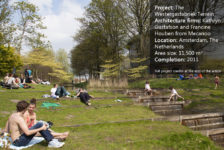Having progressed through a three-and-a-half-year undergraduate degree and a two-year part-time postgraduate program in landscape architecture, followed by another year on the Landscape Institute’s Pathway to Chartership, I sorely wish I had known then some of the things I know now. It certainly would have saved me some time and effort. Here are the Top 10 things I wish I had known while I was a landscape architecture student. 10. Other professionals and consultants have a lot to bring to the project, and it is worth getting to know them.
While at university, I wasn’t fully aware of the specialist knowledge of other professionals. I knew architects designed buildings and engineers could make it happen, but knew little else. Planners, ecologists, archaeologists, arborists, air quality specialists, acousticians, lighting designers … the list goes on. 9. There are prescribed processes for certain things. Before I started working in a landscape practice, I had little knowledge of many industry standards. From Landscape and Visual Impact Assessment to LEED and BREEAM, I wish I had known more about these things then. It would have saved me some time attempting to “re-design the wheel.” 8. Landscape design is only one part of landscape architecture. During my undergraduate years, I wasn’t aware that landscape architecture covers a wide range of jobs, including design, planning, management, and science. I think if I had known that then, I might have investigated other paths into landscape architecture. 7. Telephone beats email. When studying, I preferred to email questions I had for colleagues or product/service providers. I would then be surprised when I didn’t get a reply. As a professional, there is little time to wait for replies, so it is quicker and easier to pick up the phone and call someone. 6. There is never enough time to do enough research. In the past, I have been guilty of spending 90 percent of the project time-frame researching, leaving far too little time to exploring the design and communicating it effectively. At the end of the day, if you have not communicated your work effectively, it doesn’t matter how much time you have spent researching it — no one will notice!
“The more I learn, the more I learn how little I know.” ; image credit: Anastasios71 / shutterstock.com
- 7 Things You Should Never do as a Landscape Architecture Student!
- 10 Tips Every New Landscape Architecture Professional Needs To Know
- 5 Common Habits of Successful Landscape Architecture Students
3. Studying landscape architecture is only the beginning of a life long journey of learning. When I finished my undergraduate studies I thought I had learnt a lot. When I finished my post-graduate studies I thought the same. In the words of Socrates ‘The more I learn, the more I learn how little I know.’ 2. Ultimately, when designing public spaces, the public is our client. Through working with many built projects, I have learned that it is the public that will use the space daily and it is the public that I serve. This doesn’t mean that every design should be a dull “imagining” of a shopping list of public “wants”, but it should meet people’s needs in a safe and engaging manor. 1. Concept is not the Holy Grail of landscape design.
When I was at college, the top question my classmates and I would always ask each other was “What’s your concept?” There’s nothing wrong with wanting to use your work to communicate something above the program, ecology, and aesthetics. However, I have learned that a great landscape design works spatially, aesthetically, and with an attention to program. In the past, my colleagues and I spent too much time worrying about the concept (often to the detriment of the overall design). There are many things that I wish I had known when I was a landscape architecture student — things like a greater awareness of industry standards and processes would have saved me time, while not focusing too much on the concept and devoting more time to making sure the design worked would have made my designs better. Not knowing these things is what being a student is all about. We are there to learn, and it is only through making mistakes and exploring different avenues that we can learn. Article by Ashley Penn Return to Homepage Featured image:Milan Bruchter / shutterstock Published in Blog












